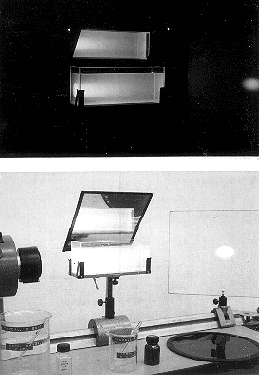

PURPOSE: Classic colloidal sunset demonstration.
DESCRIPTION: The collimated white light from the bright point source passes through the empty tank and hits a nearby screen. Chemicals previously prepared are then mixed in the tank: 2.5 ml hypo in 100 ml water, and 2.5 ml concentrated HCl 1:4 dilution in 650 ml water. When the chemicals mix they begin to form a suspension of sulfur particles which act as scattering centers for the light, especially blue light at first. This leaves the light on the screen with a yellowish tint. As time passes the sulfur particles grow larger and scatter more light and light of a longer wavelength, changing the light on the screen to a bright red. Ultimately most light is scattered, leaving no light on the screen.
It takes about 5 minutes for the screen to go dark. While that is happening you can talk about the sky being blue, the sun red at sunset, and even why the moon takes on a slightly red tint when it is near the horizon.
The scattered light can be seen to be polarized by rotating a polaroid sheet in the light path.
SUGGESTIONS:
REFERENCES: See Demonstration Reference File.
EQUIPMENT: Bright point source with condenser and iris, water tank with mirror, screen, and previously prepared chemicals as described.
SETUP TIME: 10 min.
 |  |  |  |  |